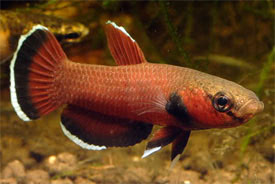
 Magyarul / Hungarian
Magyarul / Hungarian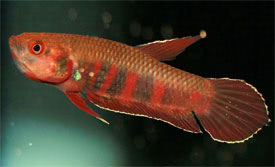
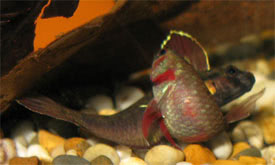
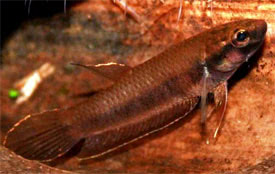

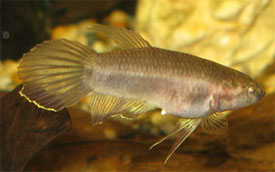
- Scientific name: Betta rubra
- Synonyms: -
- Common name: Toba betta
- Group: Labyrinth fishes
- Habitat:Asia; Northwestern Sumatra, Indonesia
- Size: 3-5 cm
- Biotope: Inhabits lowland waters, blackwater forest streams and peat swamps with very soft and acidic water. Usually these habitats are sorrounded with trees and other marginal vegetation.
- Social behavior: Not recommended for a community aquarium. Best kept in pairs in a species tank.
- Diet: Omnivorous; in nature they eat small insects and zooplankton, in aquarium they accept live and frozen foods and even quality flake foods. A varied diet of live foods such as Artemia or bloodworm will help the fish to develop their best color. Take care not to overfeed them.
- Breeding: Hard
- Tank: Minimum 40 litres
- Population: 1 pair for 40 litres
- Decoration: Use well-planted tanks with hiding places made of roots, but many breeders use bare-bottomed tanks. The addition of dried oak leaves or peat extract is recommended. Use dim lighting, and cover their tank well, as they are excellent jumpers and are susceptible to cold air!
- Temperature: 22-27 °C
- pH: 5-6.5
- Hardness: 0-5 NK°
- Lifespan: 3-5 years
Description: Toba betta has reddish to brownish body color, and the dorsum darker than ventrum. There are dark brown to black spots on the head. There are 4-7 irregularly spaced blackish bars, restricted to the lower half of the body. The fins are reddish, and the dorsal, caudal and anal fins have bright bluish-green edges. The pectoral fin base has an iridescent bluish-green spot. Betta rubra has a triangular mark below the eye, and its lower lip is black. Interesting, that there was a war in their natural habitat between the Free Sumatra Movement and the Indonesian Government resulting in Betta rubra being known only from the type specimens for around 100 years. Following a peace agreement in 2005 the area seems to have become safer as the species began to appear in the aquarium hobby during early 2007.
Males are more colorful and also they develop more extended unpaired fins as they mature, whereas females are paler or uniform in color pattern, with a black stripe on the body and with a distinct white roundish genital papilla. Interestingly, males with both rounded and lanceolate caudal-fins have been collected from the same locality in nature. Paternal mouthbrooders, they should be bred in a separated tank. The tank should have a tight cover as the fry need access to a layer of warm, humid air or the development of the labyrinth organ can be impaired. During spawning the male and female will embrace each other, and while the female releases the eggs, the male fertilises them. The male then collects the eggs directly in his mouth. A brooding male may swallow or release the eggs prematurely if stressed or inexperienced, so it’s preferable to leave the female in the aquarium. The incubation period is 10-17 days at the end of which the male will begin to release fully-formed, free-swimming fry. The parents can be removed from the tank at this point, but many breeders leave them with the fry. The fry are large enough to accept small live foods such as microworm and Artemia nauplii. They should be fed with small amounts 2-3 times per day. Also small waterchanges are essential.











